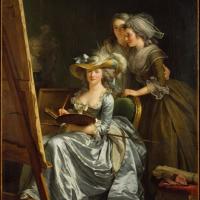Adelaide Labille Guyard
Adelaide Labille Guyard
Adélaïde Labille Guyard (1749-1803)
Adélaïde Labille-Guiard (11 April 1749 – 24 April 1803), also known as Adélaïde Labille-Guiard des Vertus, was a French miniaturist and portrait painter.
Adélaïde Labille-Guiard was born in Paris, the youngest of eight children, to a bourgeois family.
During adolescence, Labille-Guiard studied miniature painting with the oil painterFrançois-Elie Vincent, a family friend. Vincent's connections made it possible for her early works to be exhibited at the Académie de Saint-Luc. During this apprenticeship, she would meet her future husband, Vincent's son François-André Vincent.
After marrying Louis-Nicolas Guiard in 1769, she apprenticed with the pastel master Quentin de la Tour until de la Tour's marriage in 1774. After the apprenticeship, she exhibited one of her pastels of a magistrate at the Académie de Saint-Luc. She would continue displaying her works at the Académie until it closed in 1776. After that, she would display her works at the Salon de la Correspondance.
At the age of twenty, Labille-Guiard married Nicolas Guiard, a clerk with the Receiver General of the Clergy of France. The marriage contract, signed 25 August 1769, acknowledged that Labille-Guiard was a professional painter at the Académie de Saint-Luc.
The couple separated in 1777, and by 27 July 1779, were officially separated. Both kept the property they had had prior to entering marriage, since separation of property already existed under the Old Regime. After Revolutionary legislation permitted, they divorced in 1793, but Labille-Guiard retained the name Guiard, and remains known to the art world as Labille-Guiard. Thereafter, she earned a living by teaching painting.
On 8 June 1799, Labille-Guiard remarried. Her second husband was the painter François-André Vincent, winner of the Prix de Rome in 1768 and a member of the Royal Academy.
She first exhibited her art in 1774 at the Académie de Saint-Luc's Salon. After that exhibition, Labille-Guiard's works would often be compared against those of Elisabeth Vigée-Lebrun, one of Labille-Guiard's contemporaries and a fellow member of the Académie de Saint-Luc.
This show was so successful that the Royal Academy took offense, and with the backing of the monarchy, issued an edict in March 1776 abolishing "guilds, brotherhoods, and communities of arts and crafts". The Académie de Saint-Luc closed its doors in 1777.
At that point, Labille-Guiard began to learn oil painting from her childhood friend François-André Vincent so she could apply to the Royal Academy, which required her to present at least one oil painting for admission.
After the closure of the Académie de Saint-Luc, Pahin de la Blancherie established the permanent fair, Salon de la Correspondance, in 1779. For a small fee, artists outside the Royal Academy could exhibit their works. One year after its opening in 1781, Labille-Guiard chose to display some of her pastels, including her self-portrait in pastel and oil portraits of her husband and Guillame Voiriot, a teacher at the Royal Academy, which were well received by critics.
Labille-Guiard's talent as an oil painter and pastellist was quickly noticed, and with the help of François-André Vincent, who referred several of his friends in the Royal Academy to her for portraits, including Joseph-Marie Vien, the professor Bachelier, his friend Suvée, and the aforementioned Voiriot, she achieved national recognition and was accepted as a member of the Royal Academy.
On 31 May 1783, Labille-Guiard was accepted as a member of the French Académie Royale de Peinture et de Sculpture. Three other women, including Élisabeth-Louise Vigée-Lebrun, were admitted as members on the same day.
The paintings of Labille-Guiard and Vigée-Le Brun were often compared by critics, with Vigée-Le Brun usually receiving more favorable reviews. Labille-Guiard's early masterpiece Self-portrait with two pupils, exhibited at the Paris Salon in 1785, was influenced by Vigée-Le Brun's style. The artwork of Adélaïde Labille-Guiard is now considered of equal or greater value.
Patronage by the aunt of Louis XVI of France, the princess Marie Adélaïde, gained Labille-Guiard a government pensionof 1,000 livres and commissions to paint Adélaïde, her sister Victoire-Louise, and Élisabeth, the king's sister. The portrait of Adélaïde, exhibited in 1787, was Labille-Guiard's largest and most ambitious work to that date. In 1788 she was commissioned by the king's brother, the Count of Provence (later Louis XVIII of France), to paint him at the centre of a large historical work, Réception d'un chevalier de Saint-Lazare par Monsieur, Grand maître de l'ordre.
These royal connections made Labille-Guiard politically suspect after the French Revolution of 1789. In 1793 she was ordered to destroy some of her royalist works, including the unfinished commission for the Count of Provence. The exile of the Comte of Provence meant Labille-Guiard had not only lost her last royal patron, but she also did not receive a cent of the agreed upon 30,000 livres.
She was far from conservative, however. In the early 1790s she campaigned for the Academy to be reopened to women. At the Salon of 1791 she exhibited portraits of members of the National Assembly, including Maximilien Robespierre and Armand, duc d'Aiguillon.
In 1793 she and her first husband, from whom she separated in 1777, were divorced. In 1795 she obtained artist's lodging at the Louvre and a new pension of 2,000 livres. She was the first woman artist to be permitted to set up a studio for herself and her students at the Louvre. She continued to exhibit portraits at the Salon until 1800. On 8 June 1799, she married her teacher, François-André Vincent, after which she signed some of her paintings "Madame Vincent". The pastel portraits of Marie Adélaïde, Victoire-Louise, and Élisabeth stayed in Labille-Guiard's possession until she passed away from an illness. She died on 24 April 1803.




